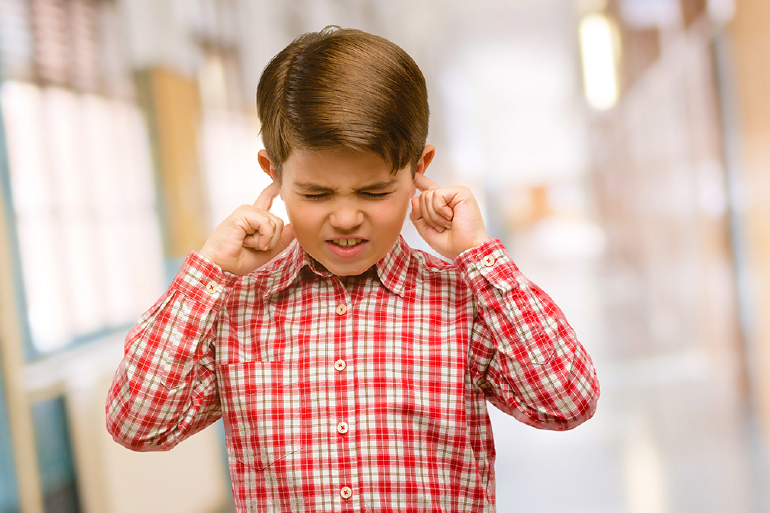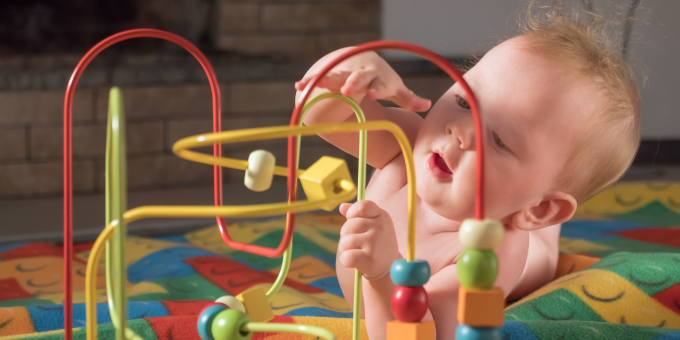
What is Sensory Processing?
Before we jump into what difficulty with Sensory Processing looks like, let’s define what it is. Sensory Processing is the process of receiving and organizing information from our senses to produce appropriate responses and reactions. We use sensory processing every day, even when we are sleeping. An example of how it may look in your daily life could be:
- I am cooking and I touch a hot pan that is sitting on the stove.
- The sensory information (heat from the hot pan) is received by the nerves on the skin. My nervous system interprets this sensation and I realize: Oh no, this is hot!
- In response to this information, I quickly move my hand away from the hot pan to avoid getting hurt.
This process allows us to be functional in our daily activities and is used in every experience we encounter. Our nervous system processes sensory information from all of our senses, from all parts of the body! But wait, how many senses do we have?
Our 8 senses – wait, we have 8?
In school we were always taught that we have 5 senses:
- Visual – the ability to see and sense brightness/darkness
- Auditory – the ability to hear and sense volumes of a sound
- Tactile – the ability to touch and feel different textures or temperatures
- Olfactory – the ability to smell different scents
- Gustatory – the ability to taste different flavours
However, we actually have 3 more senses that enable us to run, jump, catch a ball, and many other things. The 3 “hidden” senses are:
- Vestibular – the ability to sense and understand where your head and body are in space.
- Proprioceptive – body awareness; the ability to sense movement of muscles, joints, or tendons, and the location of the movement.
- Interoception – the perception of information coming from inside the body, such as knowing we are thirsty or hungry, or when we need to use the toilet.
All of our senses work together and are processed through the nervous system so that we are able to appropriately respond to the demands of our environment. As we grow and develop, we learn to better our sensory processing abilities. However, some children may struggle with sensory processing. With information coming in through 8 different senses, it is only normal that we need a little help to learn how to effectively use this abundance of sensory information! It is a lot of work for a growing and developing nervous system to learn what all this sensory information means and how to cope with it all.
What does difficulty with Sensory Processing look like?
Sensory processing difficulties may look different for everyone, and for each different sense, as each sense has a different purpose. Let’s go through the list of senses and look at how sensory processing difficulties may look like for each sense:
- Visual (seeing) – this refers to anything that we can see with our eyes. Sensory processing difficulties in this area may look like…
- Sensitivity to brightly lit environments- a person may respond by covering their eyes or squinting.
- Having difficulty finding objects that others typically would find easily.
- Enjoys looking at bright colors and patterns.
- When in a room, watches the people around them move around.
- Auditory (hearing) – this refers to anything that we can hear. Sensory processing difficulties in this area may look like…
- Having extreme or strong reactions when there is a loud noise (e.g. coffee machine, car horns, loud yelling).
- Covering ears when sounds are too loud.
- Having difficulty responding to their name being called/following instructions when there is a lot of noise around them.
- Making funny/strange noises for fun.
- Tactile (touch) – this refers to anything that we can feel on our skin. Sensory processing difficulties in this area may look like…
- Becoming distressed during grooming activities like haircuts, fingernail cutting, and washing their face.
- Being unaware of changes in temperature or pain.
- Rubbing off or wiping off areas that have been touched by others.
- Having messy hair or face but being seemingly unaware of it.
- Olfactory (smelling) – this refers to our ability to smell different scents or odors from our environment. Sensory processing difficulties in this area may look like…
- Gags easily from strong smells in the environment.
- Craving only certain foods of specific scents.
- Smelling objects that are not food.
- Gustatory (tasting) – this refers to our ability to taste different flavours. Sensory processing difficulties in this area may look like…
- Gags easily from certain flavors of food.
- Having a strong preference for only specific flavours.
- Puts objects in mouth that are not meant to be put in the mouth (e.g. fingers, toys, writing utensils).
- Vestibular – this is our ability to sense where our head is in relation to the rest of our body and where your body is in space. Sensory processing difficulties in this area may look like…
- Having stiff movements.
- Appears to have weak muscles or appears “sluggish”.
- Enjoys bending over and tipping their head downward to be “upside down”.
- Takes climbing risks regardless of one’s safety.
- Proprioception – this is our ability to sense movement of body parts by feeling tension at our muscles, tendons, and joints. Sensory processing difficulties in this area may look like…
- Tip-toe walking more than 50% of the time.
- Requires other objects to support self during standing or sitting (e.g. leaning against a wall, putting their head in their hands).
- Footsteps during walking are heavy and loud.
- Requiring weighted blankets to sleep comfortably.
My child does some of these things! What does that mean?
These behaviors are signs that a child may have sensory processing difficulties. This could mean that your child is over-responsive, under-responsive, avoidant, or seeking of certain sensory stimuli (1). In order to support your child better, it is important to understand their sensory needs. Through an occupational therapy assessment, you will be able to better understand your child’s Sensory Profile. A Sensory Profile allows us to better understand an individual’s sensory processing patterns, which has an impact on how they perform in different environments and for different activities. It additionally helps us know what sensory stimuli may be overwhelming to the child, resulting in certain behaviors that may be difficult to manage, or what sensory stimuli the child may need more of in order for improved sensory regulation.
Sensory Regulation? What is that?
Sensory regulation is our ability to manage energy levels in different environments in a healthy and socially acceptable way. You may be thinking, what does managing our energy levels have to do with sensory processing? Well, sometimes when we are over-responsive to a certain stimulus and become exposed to it, our sensory system may react by becoming overexcited, overwhelmed, or just plain upset! If we struggle to adjust how we feel and our energy levels, we become dysregulated and have difficulties sitting still, paying attention, or finding ways to cope with these feelings which are disruptive or distracting to others. We can think about our energy level like this (2):
Becoming dysregulated could mean having too much energy, or not enough energy for the tasks we need to do.
How do I help my child regulate?
The first step to helping your child regulate would be to understand their sensory processing patterns. The best way to do that is through an occupational therapy assessment and the completion of the Sensory Profile. Once their sensory processing patterns are understood, your therapist will be able to trial different activities that help to meet your child’s sensory needs. Then, the therapist will collaborate with you on strategies you can use at home to assist your child in regulation. This process is called co-regulation, where a child requires someone to help them regulate. As the parts of a child’s brain that helps them to regulate are still developing, they often require another individual to regulate. Co-regulation is done between adults as well, such as giving your friend a hug or pats on the back if they are feeling upset. Similarly, some children may require tight hugs, squeezes to the forearms or hands, or sometimes a fun activity can help to calm and regulate them – however, it is important to note that because we all have different sensory processing patterns, we must understand a child’s sensory profile first before trying any co-regulation strategies so that we avoid further dysregulating a child.
Once a child has developed more insight and ability to regulate, they can move on to self-regulation – as the name suggests, this is where an individual is able to regulate on their own. We all do this on a daily basis, such as having a coffee to wake us up when we feel sluggish after a bad night’s sleep, or taking deep breaths when we become overwhelmed. To get to this stage, a child must first have the ability to identify how they are feeling – are they too excited/angry/upset? Preparing your child with tools and strategies to help them regulate, making it a habit, and supporting them to use them would lead them to eventually being able to self-regulate.
What strategies can I use to help my child regulate?
As mentioned before, becoming dysregulated could mean having too much energy or not enough energy. We would need different strategies to target different needs.
If your child has too much energy (feeling excited or agitated), you can try:
- Deep breathing strategies. The general rule of thumb is to breathe in through your nose and out through your mouth, holding for 4-seconds at a time: 4-seconds in, 4-seconds hold, 4-seconds out. There are lots of online resources for deep breathing. These resources are great as they have printable versions which act as instructions and visual cues for the breathing exercises.
- Animal yoga or kids yoga. Slow movements can help to calm your child. There are videos on YouTube for kids yoga that you can follow! If you prefer a “screenless” approach, you could look online for kids yoga visuals, print out the pictures, and create a dice with them! Roll the dice and see what yoga pose you get. Alternatively, put the pictures in a bag and be surprised by what you pick out!
- Heavy work. Activities like lifting heavy objects, pushing heavy weights, and even digging in the garden. Activities which provide some resistance during movement helps to slow down movement and calm the sensory system.
Alternatively, if your child is feeling a little tired or sleepy, you can try:
- Dance party. Throwing on your child’s favorite songs and dancing along with them. Movements and music help to increase energy levels, allowing the child to be more alert and engaged in their surroundings.
- Big movement activities. This could include running, jumping, crawling, or mixing them all together. Involving these movements in an obstacle course or game could help to increase energy levels.
- Swings. Sitting on a swing or trying out different types of swings could be helpful. Different swinging motions have different effects on the sensory system, such as back and forth swinging is calming, while spinning motions are alerting. Try out different swinging movements with your child to see which type they best respond to.
What next?
Sensory processing, sensory regulation, and the nervous system are interlinked and can be tricky to navigate. If you are feeling unsure about your child’s behaviors and habits, a trained professional such as an Occupational Therapist can assist you in gaining a better understanding of your child’s sensory processing patterns and also how to better support them according to their specific sensory needs. The therapist will be able to better explain your child’s sensory processing patterns to you, what their needs are, and strategies that you can use at home to assist them in co-regulation. As children grow, the demands of their environments increase, and we want to be able to support them the best we can. If you do feel that you would like some help from an Occupational Therapist, do not hesitate to contact Dynamics Success Centre via our web page or drop us an email. We hope to see you soon!
References:
- Dunn, W. (1997). The impact of sensory processing abilities on the daily lives of young children and families: A conceptual model. Infants & Young Children, 9(4), 23–35.
- https://www.griffinot.com/sensory-regulation-strategies-what-are-they-and-how-can-they-help-your-child/




